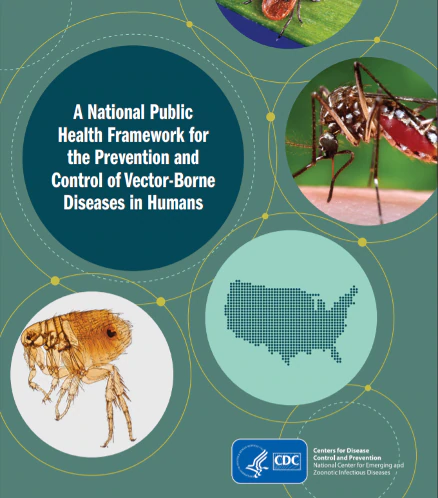In response to the Kay Hagan Tick Act of 2019, HHS is collaborating across the federal government to create an interagency national strategy with vector-borne disease objectives, activities, performance metrics, and a coordination and monitoring plan. This includes tick-borne diseases like Lyme disease.
As part of this greater federal effort on vector-borne diseases, HHS and the Steven & Alexandra Cohen Foundation launched the LymeX Innovation Accelerator (LymeX) to accelerate Lyme Innovation progress and address the growing magnitude of Lyme disease and its serious impact on the American people. The LymeX partnership has bold goals for innovation, disrupting the status quo, and changing the Lyme disease landscape. The HHS Tick-Borne Disease Working Group (TBDWG) also contributed the recently published 2020 TBDWG Report to Congress.
Background of the National Public Health Framework for the Prevention and Control of Vector-Borne Diseases in Humans

Multiple federal agencies collaborated to develop the National Vector-Borne Disease Framework, published by the Centers for Disease Control and Prevention (CDC) in September 2020. This framework identifies seven goals with strategic priorities and federal agency roles, providing a preliminary high-level framework with essential vector-borne guidance, and shows exactly why the LymeX partnership is so valuable right now.
How we will Implement the Goals of the Framework
In collaboration with many agencies and collaborators, we plan to achieve multiple goals of the framework, which directly informs the LymeX approach and activities.
- Better understand when, where, and how people are exposed to and get sick or die from vector-borne diseases
The Health+ engagement model is critical to help identify risk factors through detailed interviews with patients. Crowdsourcing is also an integral part of how we engage people in the process. We will develop personas and disease profiles to understand Lyme disease’s impact from the patient perspective.
- Develop, evaluate, and improve tools and guidance for the diagnosis and detection of vector-borne diseases
We’re adding an element of competition to jumpstart ideas for new diagnostic tests. The prize challenges will breathe life into new guidelines for Lyme disease diagnosis and management. We will leverage existing investments in sample Lyme biorepositories ("biobanks"). Those repositories will provide valid scientific evidence and support participants’ development of new tools.
- Develop, evaluate, and improve tools and guidance for the prevention and control of vector-borne diseases
Through Health+ and crowdsourcing with HHS open innovation methods, we will identify and share evidence to support vector-borne disease prevention guidelines. We will invite the public to share their ideas, develop new apps and tools, communicate critical information, and raise awareness about Lyme disease and tick-borne diseases.
- Disseminate and support the implementation of effective public health vector control products, tools, and programs to prevent, detect, diagnose, and respond to vector-borne disease threats
We will raise awareness about Lyme disease to at-risk people and communities. As the LymeX partnership demonstrates progress, it can serve as a model for other public-private partnerships.
With the framework guiding us as our true north, we’re announcing the next step – HHS has issued a Request for Information (RFI) to solicit public input regarding strategic goals, benchmarks, gaps, and opportunities to enhance coordination, data collection, research, and the development of diagnostics, treatments, vaccines and other related activities across HHS and other federal departments. We encourage public comments to be submitted online via the Federal Register or at https://www.regulations.gov/commenton/HHS-OASH-2021-0012-0001. Your comments will be essential in co-creating the development of a national strategy. Thank you for joining us to change the status quo for Lyme and other vector-borne diseases.


